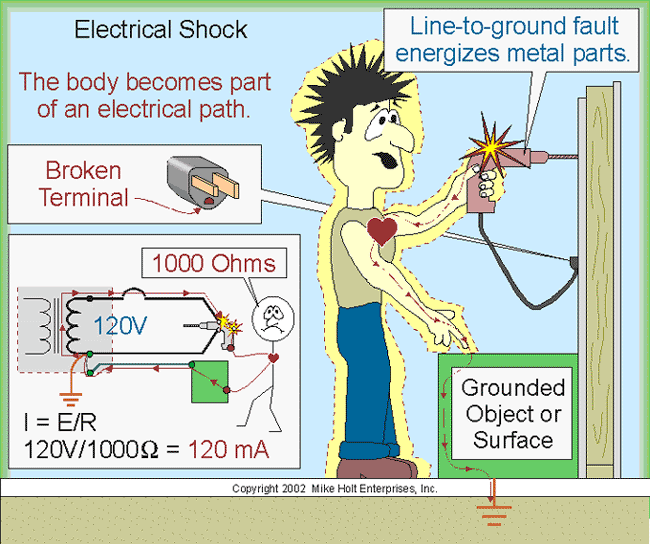Back To Basics Article, EC&M
By Mike Holt
If electrical systems are not properly wired to remove dangerous voltage, persons can be subjected to electric shock, which can result in injury or death. The National Safety Council estimates that approximately 300 people in the United States die each year because of an electric shock from 120 or 277V circuits. People become injured and death occurs when voltage pushes electrons through the human body, particularly through the heart. An electrical shock from as little as 50V alternating current for as little as one second can disrupt the hearts rhythm resulting in death in a matter of minutes from ventricular fibrillation.
According to the American Heart Association, ventricular fibrillation (VF) is a life threatening condition in which the heart no longer beats but "quivers" or fibrillates very rapidly - 350 times per minute or more. To avoid sudden cardiac death, the person must be treated with a defibrillator immediately. Cardiopulmonary resuscitation (CPR) provides some extra time, but defibrillation is essential for surviving ventricular fibrillation.
What determines the severity of electric shock?
The severity of an electric shock is dependent on the current flowing through the body, which is impacted by the electromotive force (E) measured in volts and the contact resistance (R) measured in ohms, using the formula is I = E/R.
Electric Shock Values
- Electrical Sensation. Tingle sensation occurs at about 0.25 to 0.5 mA for an adult female and between 0.50 and 1 mA for an adult male.
- Uncomfortable Sensation. Current over 1 - 2 mA is very uncomfortable to both sexes.
- Maximum Let-Go Level. The maximum Let Go Threshold level for a female is approximately - 9 mA and for a male it is about - 15 mA.
The "Let Go" Threshold is the current level where we lose control of our muscles and the electricity causes muscles to contract until the current is removed.
According to the IEEE Std. 80, the maximum safe shock duration can be determined by the formula Seconds = 0.116/(E/R), where R (resistance of person) is assumed to be 1000 ohms.

For a 120V circuit the maximum shock duration = 0.116/(120V/1000) = 1 Second
For a 277V circuit the maximum shock duration = 0.116/(277V/1000) = 0.43 Second
To protect against electric shock from dangerous voltages on metal parts of electrical equipment from a ground-fault must be quickly removed by opening the circuit’s overcurrent protection device. The time it takes for an overcurrent protection device to open and clear a ground-fault and remove dangerous voltage is inversely proportional to the magnitude of the fault current. This means that the higher the ground-fault current, the less time it will take for the overcurrent device to open and clear the fault.
An inverse time circuit breaker or fuse most likely will prevent serious electric shock if the ground-fault current is at least six times the rating of the overcurrent protection device. For a 20A circuit, the ground-fault current should be at least 120A.
As is apparent, the impedance of the fault current path plays a critical and vital role in removing dangerous voltages from metal parts by facilitating the opening of the branch-circuit overcurrent protection device to prevent electric shock or electrocution.
If you have any comments or feedback, please let me know, Mike@MikeHolt.com


3 comments:
Combine tight day game with an invitation to your amazing high status social event. You'll be going through 10's like a bowling ball.
We had already talked about it sometime back. Its of no use shouting at top of the voices against the discrimination unless the pvt co join hands together and arm twist the MoD to accept there products.
Test and tagging is a complete computer based service of combining Workplace Health & Safety, Testing & Tagging of Portable Electrical Equipment with Asset Tracking.
Post a Comment